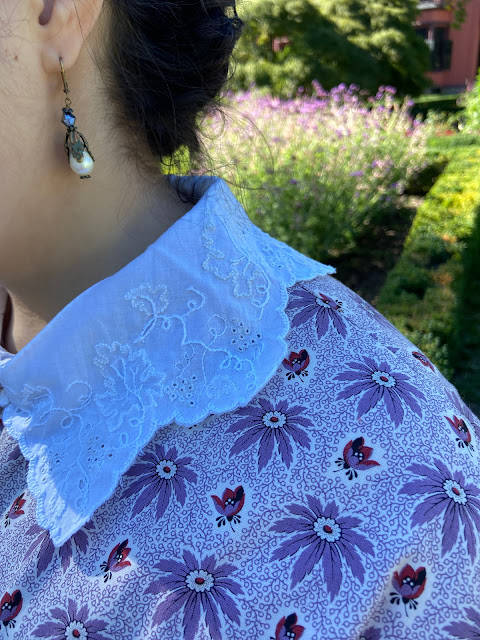While stuck at home in 2020, I had a hard time transitioning to being on the computer so much when my job had previously involved a lot of human interaction. (Meetings, I mean meetings.) To help myself focus, I turned back to an old trick I used to keep my mind and hands occupied while in college: embroidery. I would plan projects and practice stitches at night, and then work my way through the project during endless zoom calls.
I started with a crewel pocket, because I felt more familiar with the stiches and it gave me a chance to try a bunch of different things.
 |
| also, birds! |
After that, I decided to try something different and ended up settling on whitework. Traditional whitework includes a variety of different styles and techniques, all executed in white thread on white fabric. I've always loved white on white embroidery - I made some truly disastrous attempts at applying it to corsets back in the day - so lockdown seemed like a fine opportunity to really take my time and learn. For that task I turned to the excellent books and online materials from the Royal School of Needlework: for this project I referenced Whitework RSN Essential Stitches Guide by Lizzie Lansberry as well as the RSN's online stitch bank.
As a first project, I decided to make a mid-19th century collar. Separate collars and cuffs were common throughout the 19th century as they could be tacked on to different items and removed for cleaning. It's one of those little bits that makes an ensemble feel really lived-in...and also something I've been sadly lacking for my daywear. So a practical, small thing I could actually wear and wouldn't be too big to bite off seemed ideal!
I settled on this collar from Godey's Lady's Book September 1856:
 |
| embroidered collar with grapes and leaves, via |
I started by tracing the original source pattern from my computer screen onto a sheet of paper with pencil, and then went over it with sharpie to create a pattern I could save and re-use. Next I traced that pattern onto a scrap of lightweight cotton using a water-soluble embroidery pen. Then I got to stitching!
The vines are stem stitch, and the grapes are eyelets, and the leaves are outlined in backstitch. The instructions accompanying the pattern in Godey's say to fill in the leaves with backstitch but I decided I liked the look of the leaves better with just the outline, so that was what I did. (I intentionally started at the back of the collar, so all my initial awkwardness and mistakes aren't super noticeable.)
Once the collar was done I cut it out, hemmed the neck edge using a rolled hem stitch, soaked it to remove the embroidery pen, and ironed it over a towel. And then it was done! But given this was Spring of 2020, once it was done...nothing really happened. I think I posted a photo on Instagram, and that was that.
Fast forward two years, and I have finally worn this collar out into the world! As would have been done in the period I tacked the collar into the bodice of my purple reproduction print 1860s day bodice, which closes in front. (And which I have been wearing since 2013! and still have. not. trimmed. Seriously, this is next...)
I didn't exactly get it on center, but aside from that I am immensely pleased that this little piece has made it out into the world (or at least as far as CT!), and that it made the dress feel complete. Now I want to make more collars! For now, here are (finally!) some pictures documenting the fact that yes, I made a thing, and even better, I wore it out.
So three cheers for perfect fall weather, having the wardrobe to just bop off to a historical site in the right clothes (and right layers for the temperature) when invited, and friends who take a million photos so you get one where your face isn't doing a weird thing.
(And in case you're wondering: I am still embroidering on and off! But I don't have much to show for it yet, as I started a pretty big project after this and I've got about a third left to go. Stay tuned!)







Aww! And yay, for having clothes to be able to pull out and wear any time. I have great friends! :)
ReplyDeleteBest,
Quinn
Great embroidery skills!
ReplyDelete